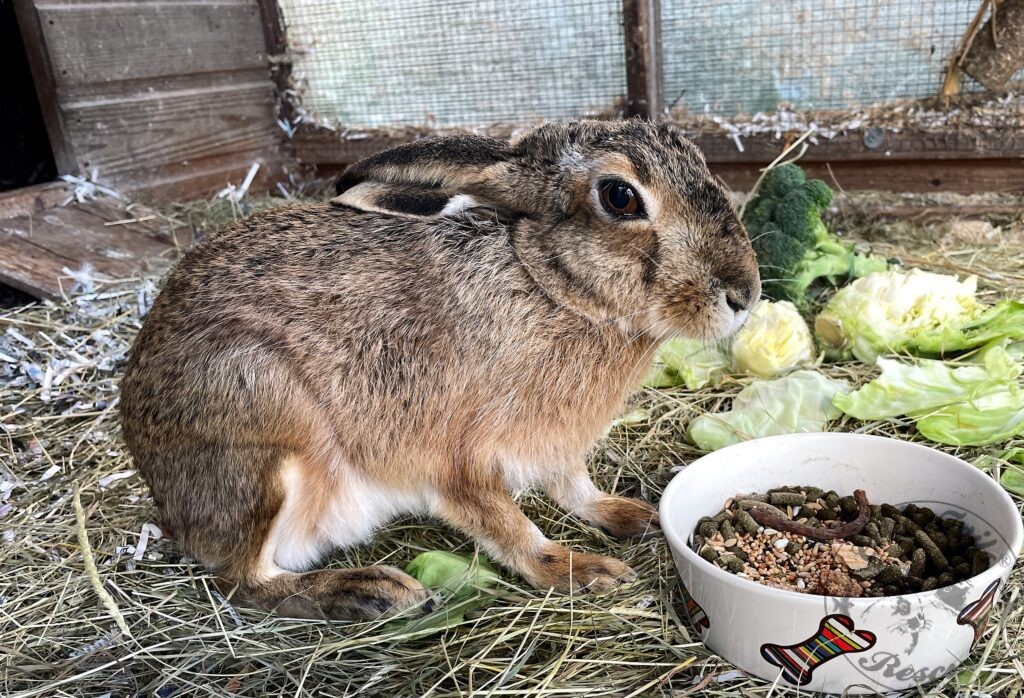Thinking about adding a unique and captivating animal to your family? Can You Have A Pet Hare? While the allure of a wild animal can be strong, it’s essential to understand the realities of hare ownership. PETS.EDU.VN provides this guide which explores the legal, ethical, and practical considerations involved in keeping a hare as a pet, ensuring you’re well-informed before making a decision. Discover if you can truly provide a suitable home for this majestic creature, covering everything from their unique needs to ethical concerns, plus alternative pet options.
1. Understanding Hares: More Than Just Big Rabbits
Before diving into the specifics of hare ownership, it’s crucial to understand what a hare is and how it differs from a rabbit. Often mistaken for one another, hares and rabbits belong to the same family (Leporidae) but different genera (Lepus for hares, Oryctolagus for rabbits). Understanding these differences is key to determining if you can meet the unique needs of a pet hare.
1.1. Key Differences Between Hares and Rabbits
| Feature | Hare (Lepus) | Rabbit (Oryctolagus) |
|---|---|---|
| Birth | Born precocial (furred, eyes open) | Born altricial (naked, eyes closed) |
| Social Behavior | Primarily solitary | Social, often live in groups |
| Habitat | Open fields, grasslands | Burrows, warrens |
| Size | Larger, longer ears and legs | Smaller, shorter ears and legs |
| Temperament | More independent and skittish | More docile and social |
| Domestication | Not typically domesticated | Domesticated for pets, meat, and fur |
| Diet | Grasses, herbs, and agricultural crops | Pellets, hay, leafy greens |
1.2. Natural Habitat and Behavior
Hares are naturally found in open environments like fields and grasslands. Their behavior is adapted to these wide-open spaces, where they rely on their speed and agility to evade predators. They are crepuscular, meaning they are most active during dawn and dusk.
Understanding their natural behavior is key to determining if you can ethically keep a hare.
- Solitary Nature: Hares are generally solitary animals, unlike rabbits who often thrive in social groups. This can make companionship challenging.
- High-Energy: Hares are built for speed and require plenty of space to run and exercise. A small cage will not suffice.
- Skittishness: Due to their wild nature, hares are often skittish and easily stressed. This can make handling difficult and impact their well-being.
1.3. Hare Species: Which Ones Are There?
There are over 30 different species of hare worldwide, each with its own unique characteristics and habitat.
However, the most common species is the European brown hare (Lepus europaeus), the species you might be considering as a pet.
Other notable species include the Arctic hare (Lepus arcticus) and the snowshoe hare (Lepus americanus).
1.4. Hare Life Cycle
Understanding the life cycle of a hare is crucial if you’re contemplating hare ownership. Hares typically live for 8-12 years in the wild, though this can be shorter in captivity. They reach sexual maturity around 6-8 months of age and can have several litters per year, with each litter containing 1-5 leverets (baby hares). The gestation period is approximately 42 days.
2. Legality: Is It Legal to Own a Hare?
The legality of owning a hare varies significantly depending on your location. Before you even consider bringing a hare into your home, it’s crucial to research and understand the laws in your area.
2.1. Regulations in Different Countries
- United States: Regulations vary by state. Some states may require permits to keep wild animals, while others may prohibit it altogether. Contact your state’s Fish and Wildlife agency for specific information.
- United Kingdom: The Wildlife and Countryside Act of 1981 protects hares, making it illegal to capture or keep them without a license.
- Australia: Hares are considered pests in many parts of Australia, and regulations regarding their ownership may vary by state and territory.
- European Union: Laws vary by country, but generally, the capture and keeping of wild hares are restricted.
2.2. Permits and Licenses
In some areas, it may be possible to obtain a permit or license to keep a hare. However, these permits often come with strict requirements, such as specific enclosure sizes, veterinary care standards, and restrictions on breeding or selling the animals.
2.3. Local Ordinances and Restrictions
Even if your state or country allows hare ownership, your local city or county may have its own ordinances that prohibit or restrict it. Check with your local animal control or government offices to ensure you comply with all applicable laws.
3. Ethical Considerations: Is It Right to Keep a Hare as a Pet?
Even if it’s legal to own a hare in your area, it’s essential to consider the ethical implications of keeping a wild animal in captivity. Hares are not domesticated animals, and their needs and behaviors are not well-suited to a domestic environment.
3.1. The Welfare of the Animal
Hares have specific needs that are difficult to meet in a typical household. These needs include:
- Large Enclosures: Hares need plenty of space to run and exercise. A small cage or hutch is not sufficient.
- Natural Diet: Hares require a diet of grasses, herbs, and other vegetation. Providing this diet can be challenging and expensive.
- Stress Reduction: Hares are easily stressed by handling, confinement, and loud noises. This stress can lead to health problems and behavioral issues.
3.2. Conservation Concerns
Removing hares from their natural habitat can have negative consequences for wild populations. It can disrupt social structures, reduce genetic diversity, and increase the risk of local extinctions.
3.3. Alternatives to Hare Ownership
If you’re drawn to hares because of their unique appearance and behavior, consider supporting conservation efforts or volunteering at a wildlife rescue organization. This allows you to appreciate these animals without contributing to their exploitation.
4. Practical Considerations: Can You Meet the Needs of a Hare?
Even if you’re committed to providing the best possible care for a pet hare, there are practical challenges that can make ownership difficult.
4.1. Housing Requirements
Hares need a large, secure enclosure that mimics their natural habitat as closely as possible. This enclosure should include:
- Size: At least 100 square feet of floor space per hare.
- Substrate: A natural substrate like grass, soil, or sand.
- Shelter: A sheltered area where the hare can hide from the elements and feel secure.
- Security: A secure fence that prevents the hare from escaping and predators from entering.
4.2. Diet and Nutrition
Hares require a diet that is high in fiber and low in protein. This diet should include:
- Grasses and Hay: The majority of the diet should consist of fresh grasses and hay.
- Leafy Greens: Offer a variety of leafy greens like kale, spinach, and romaine lettuce.
- Root Vegetables: Provide small amounts of root vegetables like carrots and sweet potatoes.
- Avoid Pellets: Commercial rabbit pellets are often too high in protein and can lead to digestive problems.
4.3. Veterinary Care
Finding a veterinarian who is experienced in treating hares can be challenging. Hares are susceptible to a variety of health problems, including:
- Parasites: Internal and external parasites can cause a variety of health problems.
- Dental Issues: Hares’ teeth grow continuously and can develop problems if not properly worn down.
- Digestive Issues: Hares are prone to digestive problems like gut stasis and bloat.
- Respiratory Infections: Respiratory infections can be serious and require prompt treatment.
4.4. Handling and Training
Hares are not naturally inclined to be handled or trained. They are easily stressed by human interaction and may become aggressive if forced to interact.
4.5. Costs
The costs of owning a hare can be significant. These costs include:
- Enclosure Construction: Building a suitable enclosure can be expensive.
- Food: Providing a natural diet can be costly.
- Veterinary Care: Veterinary care for hares can be expensive, especially if you need to see a specialist.
- Supplies: You’ll need to purchase supplies like water bowls, hay racks, and enrichment items.
5. Health and Well-being: Keeping Your Hare Healthy
If you decide to take on the challenge of keeping a hare, providing optimal health care is paramount to ensuring its well-being.
5.1. Common Health Problems
- Gut Stasis: A potentially fatal condition where the digestive system slows down or stops. Symptoms include loss of appetite, decreased fecal production, and lethargy. Prompt veterinary care is essential.
- Coccidiosis: A parasitic infection that affects the intestines. Symptoms include diarrhea, weight loss, and dehydration.
- Encephalitozoon cuniculi (E. cuniculi): A microscopic parasite that can cause neurological problems, kidney disease, and cataracts.
- Dental Issues: Overgrown teeth, malocclusion (misalignment of teeth), and abscesses can occur if their diet doesn’t provide enough abrasive action to wear down their teeth.
- Respiratory Infections: Pneumonia and other respiratory infections can be caused by bacteria, viruses, or fungi.
5.2. Preventative Care
- Regular Veterinary Checkups: Take your hare to a veterinarian experienced in treating hares at least once a year for a checkup.
- Parasite Control: Your veterinarian can recommend appropriate parasite control products.
- Dental Care: Provide plenty of hay and other fibrous foods to help wear down their teeth.
- Vaccinations: There are no vaccines specifically for hares, but your veterinarian may recommend vaccinating against certain diseases that are common in rabbits.
5.3. Recognizing Signs of Illness
- Changes in Appetite or Drinking Habits: A sudden decrease or increase in appetite or water consumption can be a sign of illness.
- Changes in Fecal Production: Decreased or absent fecal production, or changes in the consistency or color of feces, can indicate a digestive problem.
- Lethargy or Weakness: A decrease in activity level or a reluctance to move can be a sign of illness.
- Respiratory Distress: Difficulty breathing, wheezing, or coughing can indicate a respiratory infection.
- Abnormal Behavior: Changes in behavior, such as aggression, hiding, or circling, can be a sign of neurological problems.
5.4. Emergency Situations
- Gut Stasis: Seek veterinary care immediately if you suspect your hare has gut stasis.
- Bloat: A distended abdomen can indicate bloat, a life-threatening condition that requires immediate veterinary intervention.
- Trauma: If your hare is injured, seek veterinary care immediately.
6. Bonding and Socialization: Building a Relationship with Your Hare
While hares are not naturally social animals, it is possible to build a relationship with them through patience and understanding.
6.1. Understanding Hare Behavior
Hares communicate through a variety of behaviors, including:
- Thumping: Hares thump their hind legs to warn others of danger.
- Spraying Urine: Hares spray urine to mark their territory.
- Boxing: Hares stand on their hind legs and box with their front paws to establish dominance.
- Grooming: Hares groom themselves and each other to maintain hygiene and strengthen social bonds.
6.2. Building Trust
- Patience: Building trust with a hare takes time and patience. Don’t rush the process.
- Positive Reinforcement: Use positive reinforcement, such as treats, to reward desired behaviors.
- Avoid Punishment: Punishment can damage your relationship with your hare and make them fearful.
- Respect Boundaries: Respect your hare’s boundaries and don’t force them to interact if they don’t want to.
6.3. Safe Handling Techniques
- Support the Body: When handling a hare, always support their body and hind legs.
- Avoid Sudden Movements: Avoid sudden movements that could startle them.
- Keep Interactions Short: Keep interactions short and positive.
- Supervise Children: Always supervise children when they are interacting with a hare.
6.4. Introducing Hares to Other Pets
Introducing a hare to other pets can be challenging. Hares are prey animals and may be stressed by the presence of predators like dogs and cats.
7. Hare vs. Rabbit: Which Pet Is Right for You?
If you’re drawn to the idea of owning a lagomorph, but are unsure whether a hare is the right choice, consider a domesticated rabbit. Rabbits are more easily socialized, handled, and generally make better pets.
7.1. Comparing Temperaments
- Hares: Typically more skittish, independent, and less tolerant of handling.
- Rabbits: Can be more social, affectionate, and enjoy human interaction.
7.2. Care Requirements
- Hares: Require larger enclosures, specialized diets, and veterinary care from exotic animal specialists.
- Rabbits: Can thrive in smaller spaces, have readily available food options, and are often treated by general practice veterinarians.
7.3. Domestication
- Hares: Not domesticated, retaining their wild instincts and behaviors.
- Rabbits: Domesticated for centuries, bred for specific traits that make them better suited as pets.
7.4. Responsible Ownership
- Hares: Often obtained from the wild, potentially disrupting ecosystems and contributing to conservation concerns.
- Rabbits: Available from reputable breeders, rescues, and shelters, supporting ethical pet ownership.
8. Alternatives to Hare Ownership: Enjoying Hares Responsibly
If, after considering all of the factors, you decide that owning a hare is not the right choice for you, there are still ways to enjoy and appreciate these animals responsibly.
8.1. Supporting Conservation Efforts
- Donate to Conservation Organizations: Support organizations that work to protect hare habitats and conserve wild populations.
- Advocate for Wildlife Protection: Contact your elected officials and advocate for policies that protect hares and their habitats.
8.2. Visiting Wildlife Sanctuaries
- Visit Reputable Sanctuaries: Visit wildlife sanctuaries that provide a safe and natural environment for hares and other wild animals.
- Observe from a Distance: Observe hares from a distance and avoid disturbing their natural behavior.
8.3. Educational Opportunities
- Learn About Hares: Educate yourself about hare biology, behavior, and conservation.
- Share Your Knowledge: Share your knowledge with others and help raise awareness about the importance of hare conservation.
8.4. Ethical Wildlife Photography
- Respect Wildlife: Practice ethical wildlife photography by respecting the animals and their habitats.
- Avoid Disturbance: Avoid disturbing hares or their environment when taking photos.
- Promote Conservation: Use your photos to promote hare conservation and raise awareness about the challenges they face.
9. The Story of Bambi: A Cautionary Tale
The story of Bambi, a rescued leveret, highlights the challenges and ethical considerations involved in keeping a wild hare. While Bambi’s rescuer provided exceptional care, his story is not representative of what most people can or should do.
9.1. A Unique Case
Bambi’s case was unique because he was rescued as a very young leveret and required intensive care to survive. He also developed a close bond with his rescuer, which is not typical of hares.
9.2. The Challenges of Care
Even with the best possible care, Bambi experienced a number of health problems, including gut stasis and suspected “Brown Hare Syndrome.” These health problems required specialized veterinary care and constant attention.
9.3. Ethical Considerations
While Bambi’s rescuer had the best of intentions, his story raises ethical questions about whether it is right to keep a wild animal in captivity, even if it is for its own good.
10. FAQs About Pet Hares
Still have questions? Here are some frequently asked questions about keeping hares as pets.
| Question | Answer |
|---|---|
| Are hares good pets for children? | No. Hares are not suitable pets for children. They are easily stressed by handling and require specialized care that most children are not capable of providing. |
| Can hares be litterbox trained? | Hares can be litterbox trained, but it is not always easy. They are not as naturally inclined to use a litterbox as rabbits are. |
| Do hares need companionship? | Hares are generally solitary animals and do not need companionship. In fact, keeping multiple hares together can lead to aggression and fighting. |
| How long do hares live? | Hares typically live for 8-12 years in the wild, but their lifespan can be shorter in captivity. |
| What do hares eat? | Hares eat a variety of grasses, herbs, and other vegetation. Their diet should be high in fiber and low in protein. |
| Can hares live indoors? | Hares are not well-suited to living indoors. They need a large, outdoor enclosure that mimics their natural habitat. |
| Are hares nocturnal? | Hares are crepuscular, meaning they are most active during dawn and dusk. |
| Do hares bite? | Hares can bite if they feel threatened or stressed. Their bites can be painful. |
| Can hares be released back into the wild? | Releasing a captive-raised hare back into the wild is not recommended. They may not have the skills necessary to survive and could disrupt wild populations. |
| Are hares endangered? | Some hare species are endangered, while others are not. The conservation status of hares varies by species and location. |
Conclusion: Making an Informed Decision
Deciding whether you can have a pet hare is a complex issue that requires careful consideration of legal, ethical, and practical factors. Hares are not domesticated animals and have specific needs that are difficult to meet in a domestic environment. Before you decide to bring a hare into your home, be sure to research the laws in your area, consider the ethical implications of keeping a wild animal in captivity, and assess whether you can realistically meet the needs of a hare.
For more in-depth information on pet care and responsible animal ownership, visit PETS.EDU.VN. Our website offers a wealth of resources to help you make informed decisions about pet ownership and provide the best possible care for your animal companions.
Ready to learn more about responsible pet ownership? Visit pets.edu.vn today!
For further assistance or inquiries, contact us at 789 Paw Lane, Petville, CA 91234, United States, or reach out via Whatsapp at +1 555-987-6543. We’re here to help you make the best choices for your furry, feathered, or scaled friends.
 Hare in field
Hare in field

